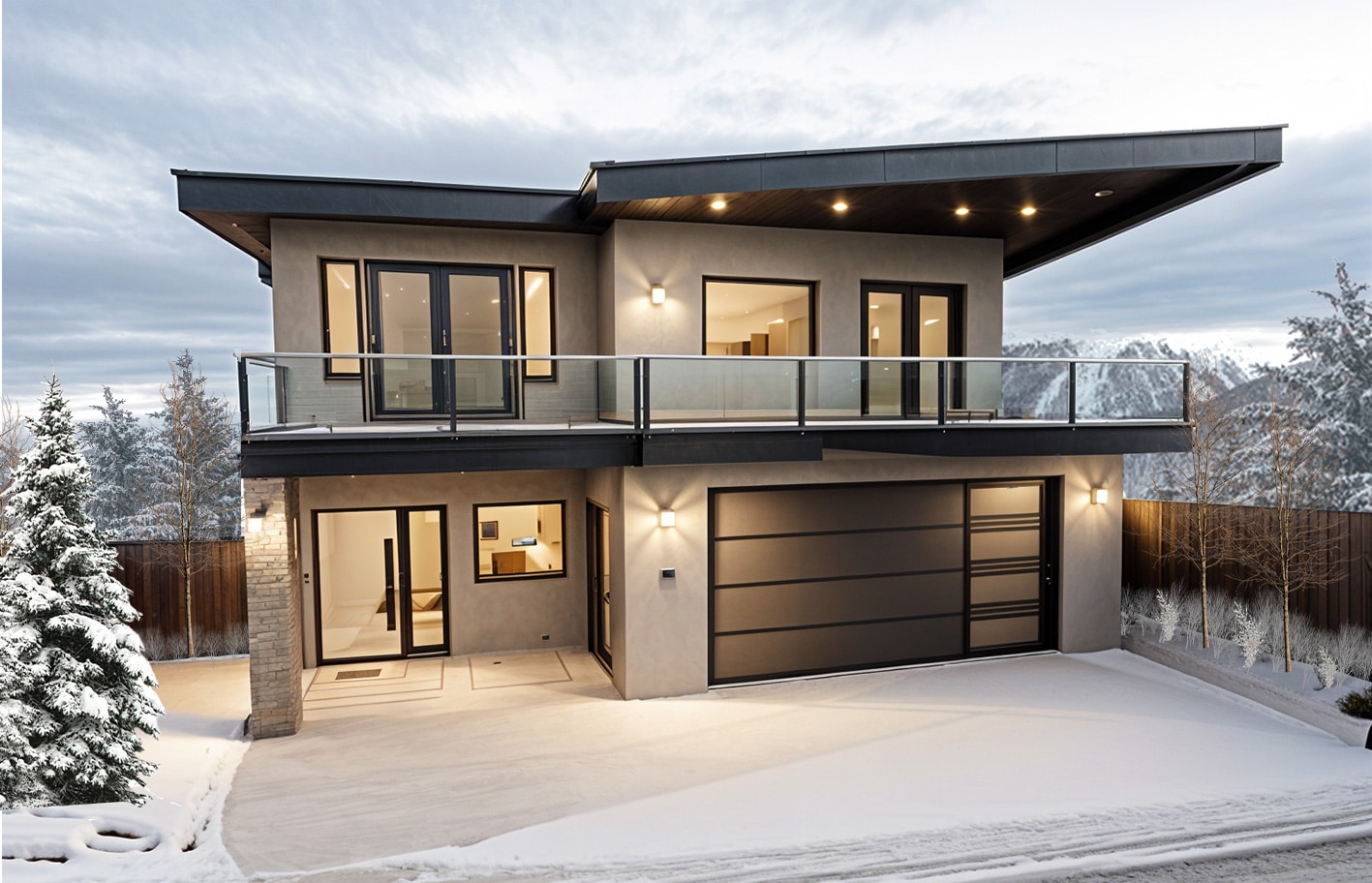When designing a home for cold climates, it’s essential to address several key factors to ensure your Okanagan custom home or renovation performs optimally and remains comfortable throughout the winter months. At LUX Homes, we carefully consider each of these elements to create a residence that excels in cold weather. From strategically positioning your home to maximize sunlight and shield it from harsh winds, to investing in high-quality insulation and energy-efficient windows, every detail is meticulously planned. Join us as we explore how LUX Homes incorporates these essential elements into our winter construction practices, ensuring your new Okanagan home is a haven of comfort and warmth all year long.
Considerations on How Winter Weather Impact the Building Process
Cold weather can significantly impact the performance of construction materials. For example, mortar, grout, and adhesives need specific temperatures to work effectively. In freezing conditions, their ability to bond can weaken, leading to potential issues like unstable joints. We tackle this by using specialized products designed for winter construction and creating optimal curing conditions, ensuring that our structures remain solid and reliable.
Concrete is another area that requires special attention during winter construction. Cold temperatures can slow its curing process, which might lead to cracks or structural problems. Insulated Concrete Forms (ICF), like Superform OKGN ICF, to maintain the right temperature for curing and ensure the concrete sets properly without freezing. Managing concrete effectively is crucial for successful winter construction and for ensuring a home that stands strong and enduring.
To handle the challenges of winter construction we use high-quality, sustainable insulation to prevent heat loss during harsh winters. Our homes are equipped with advanced technology that adjusts heating and cooling based on external conditions. We focus on airtight construction to keep out the cold and heat, ensuring that every component of the home works together seamlessly—a key aspect of effective winter construction.
Stay Ahead of Winter’s Challenges and Make Your Winter Construction a Success
Planning and flexibility are vital when managing winter builds. Given Canada’s extreme cold climate, it’s essential to anticipate and plan for potential disruptions. We emphasize detailed planning and adjust our workflows to handle winter construction challenges. When it’s too cold outside, we shift focus to indoor tasks and keep essentials like antifreeze additives and thermal blankets on hand to manage unpredictable weather.
For homeowners, maintaining comfort during winter is equally important. Regular maintenance can prevent issues like freezing pipes or heating system failures. It’s important to check insulation regularly, add layers if necessary, and ensure good airflow by running the furnace fan or using bath fans to prevent condensation—a common issue in new homes.
So, When is the Right Time to Build a Home?
Choosing the right time to build a home often comes down to more than just weather conditions. While some contractors might suggest that you can build a home any time of the year, the key is to assess the builder’s reputation and expertise. If a company frequently receives complaints, it could indicate that they may not take the necessary precautions to safeguard the quality of the foundation and overall construction during extreme weather conditions.
Once you select a builder, it’s important to heed their professional advice. Builders are experienced in managing construction timelines based on weather conditions. If your builder recommends waiting a few months before starting excavation, there’s usually a valid reason behind the suggestion. Delaying the start of construction can sometimes be beneficial to ensure the groundwork is done under optimal conditions, which can end up saving you thousands.
Additionally, if your builder urges you to make decisions quickly, it’s often because they need to avoid potential weather-related delays. Construction schedules can be affected by unforeseen weather changes, and timely decisions help prevent the loss of favorable building days.
Things to Consider When Designing for Cold Climates
When designing a home for cold climates, several key factors must be taken into account to ensure optimal performance and comfort. Here’s what to consider:
1. Orientation:
- To optimize energy efficiency in cold climates, it’s important to consider sun exposure and wind protection in your home’s design. Positioning your home to maximize passive solar gain is key;
2. The Envelope:
- Thermal Performance: The building envelope, including walls, roof, and foundation, should be designed to minimize heat loss. Use materials that provide a high level of insulation and thermal mass to maintain a stable indoor temperature.
3. Insulation:
- Investing in high-quality insulation materials and ensuring their proper installation throughout your home, including in walls, attic spaces, and floors, is crucial for maintaining warmth and energy efficiency while preventing heat loss. Look for insulation with a high R-value, which indicates its effectiveness in resisting heat flow; the higher the R-value, the better the insulation’s performance.
4. Windows and Doors:
- To enhance energy efficiency in your home, select windows and doors that are energy-efficient and well-sealed, with triple-glazed windows offering superior insulation and reduced heat transfer. Additionally, ensure that all windows and doors are properly weatherproofed to prevent drafts and minimize heat loss.
5. Interior Air Quality:
- To maintain indoor air quality in cold climates, proper ventilation is essential; energy recovery ventilators (ERVs) or heat recovery ventilators (HRVs) can introduce fresh air while minimizing heat loss. Alongside ventilation, controlling indoor humidity levels is crucial to enhance comfort and prevent problems like condensation and mold growth.
6. Heating:
- To ensure optimal comfort and savings, choose an efficient heating system that suits your home’s size and design. Options include high-efficiency furnaces, radiant floor heating, or heat pumps. Ensure regular maintenance for optimal performance. In addition, implementing zoning controls allows you to heat specific areas of the home as needed, which reduces overall energy consumption and enhances comfort.
7. The Exterior:
- For lasting protection in harsh winter conditions, select exterior materials that are resilient, such as moisture-resistant siding and durable roofing, and ensure proper sealing and maintenance to guard against snow, ice, and wind damage. Additionally, design rooflines and drainage systems to effectively manage snow and ice, thereby reducing the risk of ice dams and water damage.
8. Furnishings:
- To ensure both comfort and functionality in your home, pick furnishings that complement its warm and welcoming feel, like wool rugs and heavy drapes. Arrange the furniture to enhance the performance of your heating system and to ensure that heat sources remain easily accessible. We highly recommend reading our interior design page if you’re needing help with this.
At LUX Homes, we handle winter’s challenges with expertise in winter construction, turning winter adversities into the perfect setting for warm, welcoming homes. Whether you’re building with us or not, remember to stay proactive. Don’t just watch the temperature drop—plan and prepare. We offer plenty of resources that you can download here to guide you through the process.
Ready to build a winter-proof home without a chill? Contact LUX Homes. We don’t just face the cold; we excel in winter construction.


